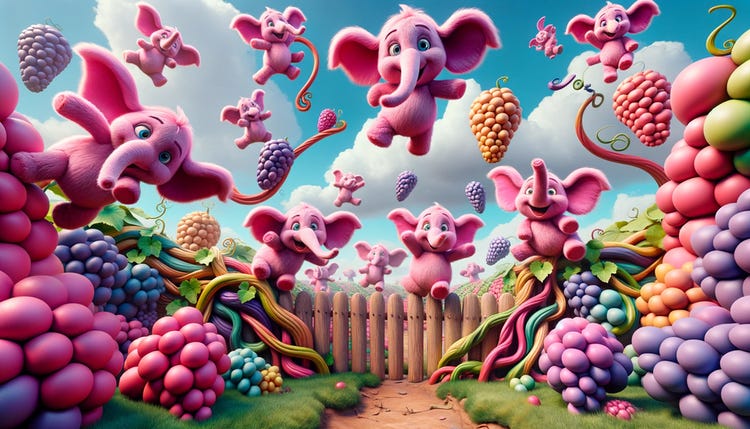Wine notes and pink elephants
I glanced at the back label: “Notes of rhubarb, plum, strawberry, rose petals, and lavender …” Whoa! I’m not going to be able to un-see that!
• Thank you for your paid subscription! You keep us going. You receive twice as many reports, and your support helps cover our costs, including the wines that I buy for review. Please help us grow by sharing our subscription link with friends who might also value this kind of advice.
• Food and wine books you’ll like
• Today’s tasting report: Folktale 2020 Monterey Carbonic Sangiovese
I hate to admit that I’m easily influenced, but it’s a fact: Once I’ve seen a list of specific flavor and aroma descriptions, it’s hard for me to ignore those suggestions when I taste the wine.
And this, of course, is why wine producers large and small typically put a tasting note on the back label. “There is no doubt that packaging, label design, and branding is incredibly important. In the wine and spirits industry, label design and branding can make or break,” wrote Joseph Smith in a June 2020 article, “How the label on the wine bottle influences your taste,” on the Discoursive blog on Medium.
This is good marketing psychology, but it plays on a very human response that can be annoying to anyone who wants to form their own opinions about a wine, a work of art, a piece of literature, just about any creative thing that we’d rather judge on our own.
Don’t think about a pink elephant! All right, now what are you thinking about?
(Image generated by DALL·E, an AI model developed by OpenAI.)
The phenomenon is so common that it has a name: The Pink Elephant problem. It works like this, explained psychologist Marina Harris, Ph.D., in her July 5, 2023 Psychology Today column, Letters From Your Therapist:
“Don’t think about a pink elephant. Whatever you do, don’t think about a pink elephant. Don’t picture a pink elephant in your mind. Just don’t do it. Now, what are you thinking of? If I were to wager, I’d bet you’re thinking of a pink elephant.”
So how do we get that wacky image of a portly pink pachyderm – or the winey scents of rose petals and lavender – out of our head?
“If you try not to think about something, you’re going to think about it more,” psychologist Harris wrote. “Instead, address the thought with three key techniques: flipping it, disarming it, or conquering it.”
I’ll refer you to her entire article for the details, which might just be helpful in more serious life situations, too. In short, though, applied to our wine-tasting pink elephant brought about by the wine label, here’s my wine-tasting take on her specific suggestions:
Flip it: Don’t think about the descriptors that the back label presented. Focus on what’s in the glass and approach it with an open mind.
Disarm it: Acknowledge the presence of the distracting flavor impressions and move on.
Conquer it: Put all this in perspective. Messing with your tasting impressions is probably not the worst thing that will happen to you this week. Enjoy the wine, and you’ll probably start forming your own uninfluenced impressions. That pink elephant isn’t as scary as we tend to think.
Now, let’s take a look at the tasty, offbeat red wine that inspired this train of thought.
Keep reading with a 7-day free trial
Subscribe to The 30 Second Wine Advisor to keep reading this post and get 7 days of free access to the full post archives.





